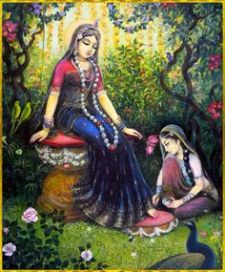Gurudeva says that there are five things that determine the qualification of one as a pure devotee especially in the path of Raganuga Bhakti. They are Vishwaas (Complete faith), Samarpan (Complete Surrender), Vinamrata (Humility), Sadachar (Vaishnava Etiquette) and Radha Dasyam (Exclusive service to Srimati Radharani).
Vishwaas refers to one’s faith in the system and parampara. It refers to one’s complete identification with the system as enunciated by Sriman Mahaprabhu and thereby following all the principles set by the previous Acaryas. This involves a deep study of the philosophy and strengthening one’s faith on the system. The next aspect is of Surrender or Samarpan. When one is convinced of the pure original philosophy as enunciated by Sriman Mahaprabhu, one takes the shelter of an authentic Guru in the Parampara and then submissively serves him. Surrender to Guru is the most important aspect of the system. Without taking complete shelter of a Sadhguru in the parampara and submissively knowing from him, the deep confidential aspects of the system , one can never qualify to the higher moods of Raganuga Bhakti.
When one continuously serves Guru just as the continuous homogenous flow of oil from one vessel to another, one understands the mood of Gurudeva and goes all out to make Gurudeva happy with one’s unprecedented service. When there is no surrender or faith in the words of Guru, the aspect of humility can never develop. As one matures in one’s service to Guru, one develops true humility (Vinamrata). Under the guidance of the Guru one becomes qualified to serve the Vaishnava Community as a whole. This process automatically brings to the fore the aspect of Vaishnava Sadachar. This concept is the matured fruit of the first three processes of Vishwaas, Samarpan and Vinamrata. Vaishnava Sadachar represents Vaishnavata (perfect internal mood of a Vaishnava) and this aspect cannot be artificially cultivated. It is the very mood of service to Guru, Shastra,  Vaishnavas and Bhagawan. When one develops Sadachar one becomes free from the six vices of Kama, krodha, lobha, moha, mada and matsarya. One becomes free from slander, malice and fault-finding nature. Gurudeva calls it the stage of Aprakriti. There are two modes; one natural and one divine. The Aprakriti stage is that of divinity when one is successful in reversing one’s natural qualities which is normally nurtured by the six vices. It is likened to a swimmer swimming against the flow of a torrential river. Only when one matures in these stages can one perform Bhajana. Bhajana in the context of Raganuga represents Radha Dasyam. As one becomes extremely vigilant of one’s internal mood, one becomes automatically qualified to enter into the higher stage of Prayojana or the Ultimate Goal which is serving Srimati Radha in the mind in the mood of a handmaid of Vraja. This is the highest conception in Bhakti as given to all of us by Sriman Mahaprabhu. In this mood it is considered that direct service to Sri Krishna is a transgression and an aberration. One will only serve Srimati Radharani and will serve Krishna only indirectly only if Swamini (Srimati Radha) wills otherwise an aspirant of Raganuga is simply only interested in serving Sriji (Srimati Radha) and no one else. This is the purport of the Gaudiya Vaishnava Parampara.
Vaishnavas and Bhagawan. When one develops Sadachar one becomes free from the six vices of Kama, krodha, lobha, moha, mada and matsarya. One becomes free from slander, malice and fault-finding nature. Gurudeva calls it the stage of Aprakriti. There are two modes; one natural and one divine. The Aprakriti stage is that of divinity when one is successful in reversing one’s natural qualities which is normally nurtured by the six vices. It is likened to a swimmer swimming against the flow of a torrential river. Only when one matures in these stages can one perform Bhajana. Bhajana in the context of Raganuga represents Radha Dasyam. As one becomes extremely vigilant of one’s internal mood, one becomes automatically qualified to enter into the higher stage of Prayojana or the Ultimate Goal which is serving Srimati Radha in the mind in the mood of a handmaid of Vraja. This is the highest conception in Bhakti as given to all of us by Sriman Mahaprabhu. In this mood it is considered that direct service to Sri Krishna is a transgression and an aberration. One will only serve Srimati Radharani and will serve Krishna only indirectly only if Swamini (Srimati Radha) wills otherwise an aspirant of Raganuga is simply only interested in serving Sriji (Srimati Radha) and no one else. This is the purport of the Gaudiya Vaishnava Parampara.
